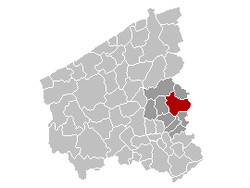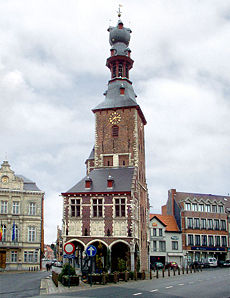- Tielt
-
Tielt 
Flag
Coat of armsLocation in Belgium Coordinates: 51°00′N 03°19′E / 51°N 3.317°E Country Belgium Region Flemish Region Community Flemish Community Province West Flanders Arrondissement Tielt Government - Mayor Michiel Van Daele (CD&V) - Governing party/ies CD&V, N-VA Area - Total 68.50 km2 (26.4 sq mi) Population (1 January 2010)[1] - Total 19,647 - Density 286.8/km2 (742.9/sq mi) Demographics - Foreigners 1.25% (7 January 2005) Postal codes 8700 Area codes 051 Website www.tielt.be Tielt is a Belgian municipality in the province of West Flanders. The municipality comprises the city of Tielt proper and the towns of Aarsele, Kanegem, and Schuiferskapelle.
Contents
History
Some traces of Gallo-Roman occupation have been found in this area. The area was invaded by the Viking Rikiwulf of the Wulfing dynasty in 880, who built Rikiwulfinga-haim, which survives as the Rijkegem-kouter today. The first written mention of Tiletum, however, dates from 1105. In 1245, Margaret of Constantinople, Countess of Flanders gave the city its charter and decided to found a hospital here. A few years later, a market place and cloth hall were built as well. Like neighbouring Roeselare, Tielt was made part of the Kortrijk province of Flanders. In the 13th and 14th century, the economy of most Flemish cities was based on the cloth industry, while the rural areas lived on the products of agriculture.
In 1393, Philip the Bold decided to hold an annual fair in Tielt, which resulted in the city becoming the booming centre of the flax industry until the end of the 16th century. The following decades, however, were hard on Tielt as it went through two major fires and a couple of epidemics, including the plague. Tielt also went through a severe famine at the end of the 17th century. From about 1700 until the Belgian Revolution of 1830, the city prospered again, this time as a regional center for the construction industry.
During World War I, the city became the headquarters for the German army. The bombing of the Second World War was a lot more destructive. Most of the city centre had to be rebuilt. Today Tielt is a typical province town, which offers commercial, medical and educational services to the surrounding region.
Sights
- The Belfry (Hallentoren), Cloth Hall, and Aldermen’s Chamber are classified by UNESCO as a World Heritage Site.
- The city also houses some interesting churches such as Saint-Peter’s.
- From Tielt, there are several strolling and biking paths that allow the visitor to discover the region and see some of the windmills that still dot the landscape.
Festivities
Every year, on the first week-end of July, the city celebrates the Europafeesten (feast of Europe). This is the occasion for a braderie (a street clearance sale), street theatre, a blues festival, fireworks, and of course, expanded café terraces for further merriment.
People born in Tielt
- Josse Ravesteyn, 16th-century theologian
- Godfried Danneels, cardinal in the Roman Catholic Church
- Briek Schotte, two-time World Champion cycling
Industry
- Seyntex, textile manufacturer.
International relations
See also: List of twin towns and sister cities in BelgiumTwin towns — Sister cities
Tielt is twinned with:
References
- ^ Population per municipality on 1 January 2010 (XLS; 221 KB)
External links
- Official website - Information available in Dutch and limited information available in English
Bruges Beernem · Blankenberge · Bruges/Brugge · Damme · Jabbeke · Knokke-Heist · Oostkamp · Torhout · Zedelgem · Zuienkerke
Diksmuide Kortrijk Ostend Roeselare Tielt Veurne Ypres Heuvelland · Ieper/Ypres · Langemark-Poelkapelle · Mesen · Poperinge · Vleteren · Wervik · ZonnebekeCategories:- Municipalities of West Flanders
- Populated places in Belgium
- World Heritage Sites in Belgium
Wikimedia Foundation. 2010.



